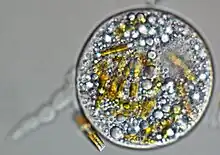Tectofilosid
The tectofilosids are a group of filose amoebae with shells. These are composed of organic materials and sometimes collected debris, in contrast to the euglyphids, which produce shells from siliceous scales. The shell usually has a single opening, but in Amphitrema and a few other genera it has two on opposite ends. The cell itself occupies most of the shell. They are most often found on marsh plants such as Sphagnum.
| Tectofilosida | |
|---|---|
 | |
| Two preserved specimens of Capsellina sp. (Chlamydophryidae), from the Eugène Penard collection | |
| Scientific classification | |
| Domain: | Eukaryota |
| Clade: | Diaphoretickes |
| Clade: | SAR |
| Phylum: | Cercozoa |
| Class: | Thecofilosea |
| Subclass: | Tectosia Cavalier-Smith 2012 |
| Order: | Tectofilosida Cavalier-Smith & Chao, 2003[1] |
| Suborders & families | |
| |
This group was previously classified as the Gromiida or Gromiina. However, molecular studies separate Gromia from the others, which must therefore be renamed. They are placed among the Cercozoa, and presumably developed from flagellates like Cryothecomonas, which has a similar test. However, only a few have been studied in detail, so their relationships and monophyly are not yet certain.
In a recent classification, the group Tectofilosida was not used: Chlamydophryidae, Psammonobiotidae, Pseudodifflugiidae and Volutellidae were dispersally placed in Thecofilosea, while Amphitremidae was included in Labyrinthulomycetes.[2]
Taxonomy
- Order Tectofilosida Cavalier-Smith & Chao 2003 (paraphyletic)
- Suborder Lithocollina Cavalier-Smith 2012[3]
- Family Lithocollidae Schulze 1874
- Suborder Unitremina Cavalier-Smith 2012
- Family Rhizaspididae Howe et al. 2011 [Rhizaspidaceae Skuja 1948]
- Family Fiscullidae Dumack et al. 2017[4]
- Family Pseudodifflugiidae De Saedeleer 1934
- Family Psammonobiotidae Golemansky 1974 emend Meisterfeld 2002
- Family Chlamydophryidae de Saedeleer 1934 emend. Meisterfeld 2002
- Family Volutellidae Sudzuki 1979
- Suborder Lithocollina Cavalier-Smith 2012[3]
References

- Cavalier-Smith T, Chao EE (October 2003). "Phylogeny and classification of phylum Cercozoa (Protozoa)". Protist. 154 (3–4): 341–58. doi:10.1078/143446103322454112. PMID 14658494.
- Adl SM, Simpson AG, Lane CE, Lukeš J, Bass D, Bowser SS, Brown MW, Burki F, Dunthorn M, Hampl V, Heiss A, Hoppenrath M, Lara E, Le Gall L, Lynn DH, McManus H, Mitchell EA, Mozley-Stanridge SE, Parfrey LW, Pawlowski J, Rueckert S, Shadwick L, Shadwick L, Schoch CL, Smirnov A, Spiegel FW (2012). "The revised classification of eukaryotes". J. Eukaryot. Microbiol. 59 (5): 429–93. doi:10.1111/j.1550-7408.2012.00644.x. PMC 3483872. PMID 23020233.
- Cavalier-Smith, Thomas; Chao, Ema E. (2012). "Oxnerella micra sp. n. (Oxnerellidae fam. n.), a Tiny Naked Centrohelid, and the Diversity and Evolution of Heliozoa". Protist. 163 (4): 574–601. doi:10.1016/j.protis.2011.12.005. PMID 22317961.
- Dumack, Kenneth; Mausbach, Paul; Hegmann, Mona; Bonkowski, Michael (2017). "Polyphyly in the Thecate Amoeba Genus Lecythium (Chlamydophryidae, Tectofilosida, Cercozoa), Redescription of Its Type Species L. Hyalinum, Description of L. Jennyae Sp. Nov. And the Establishment of Fisculla Gen. Nov. And Fiscullidae Fam. Nov". Protist. 168 (3): 294–310. doi:10.1016/j.protis.2017.03.003. PMID 28499131.